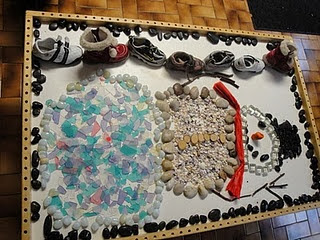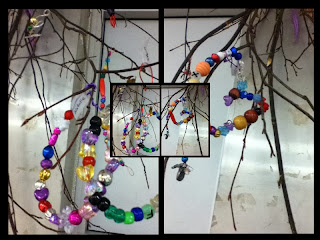Our new provocation at our nature table is a beautiful display of shells. The children were intrigued by the different shells – some we had placed in a two-tiered basket, others in a multi-compartment basket (we thought they might like to sort them), and still others on brown felt squares and circles to highlight their delicate colours. We also placed some shells in a tall mason jar. A magnifying glass was near by to help the children look closely.
There were lots of explorers at the nature table in the first few days. They touched the shells, noting the surface textures. They held up the large conch shell to their ears, claiming to hear to the ocean. The children made many observations…
What is this? It’s a starfish. It’s smaller. Do you want to see my booklet?
Is this a sea urchin?
It’s sharp. (They both smelled the shell).
I made a clipboard (booklet) and then you can bring both of them home. And then you can decorate the front.
What is that? What is that little white stuff on them? Is that a real starfish? It’s dead. These are spiky balls. Hey come and see these spiky guys! Follow me. Look at these spiky fellows! They hurt. Are these actually animals?
These are shells. Some had animals that died.
This is totally rouge.
I’m going to make seashells.
We were just discovering shells.
We found several resource books, including our Looking Closely book, to help us explore our beach finds. There was a perfect picture in our Looking Closely book of a conch shell. We also had a basket with booklets made for the children to record their thinking and a mason jar filled with coloured pencil crayons. A few mirrors helped to reflect the shells’ contours from different angles.
Our learning continued guided by the children's interest. One day, someone brought in a beautiful starfish with a lovely story. We gathered on the carpet and discovered it during our afternoon circle time. We had placed the starfish on a silver tray and covered it with a cloth. We spoke at first in hushed tones about a special treasure that we wanted to share. Lots of oohs and aahs as we revealed the surprise. The children were interested in sharing what they already knew about starfish and what they might like to find out.
I brought a starfish.
Spiky
You might hurt yourself, don’t throw it or it will break.
Everyone can take a turn and touch it.
It protects it. Spiky.
It was in the sea. Her grandma was swimming and saw it in the ocean.
A starfish is a kind of fish.
It has spikes to protect it.
If it touches it, it is dangerous.
A starfish has spikes at the top and is not very big.
Maybe someone was swimming for a long time and found it and was going to put a starfish…
Can you flip it over; there’s a starfish there.
[We can do a bit of research] about a starfish.
Nobody ate the starfish.
Later that afternoon, we went to the library to take out some books about starfish. Our starfish inquiry has begun...











































